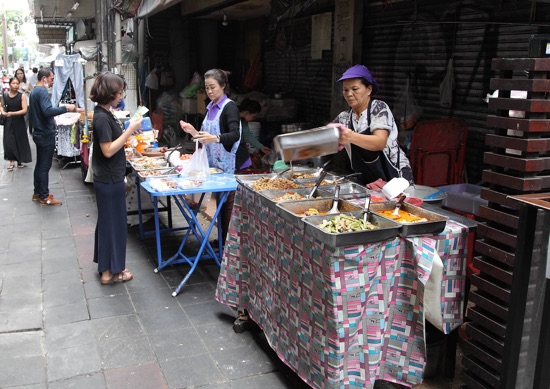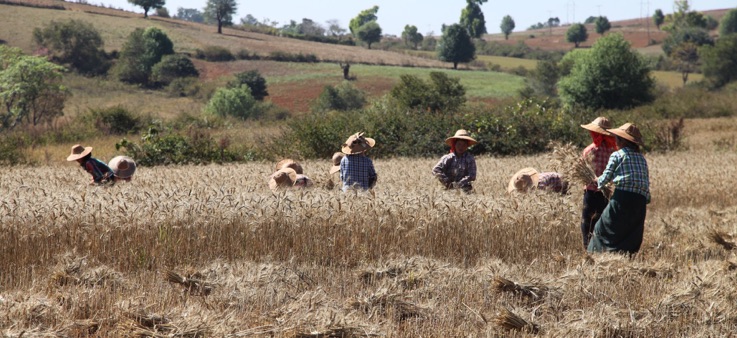News
27 March 2020
COVID-19 and food - The pandemic is likely to cause a major food crisis
While the virus may not make any difference between the rich and the poor, inequalities will be real during the food crisis bound to be a consequence of the COVID-19 pandemic. Considerable injustice exists between rich and poor countries, and between the rich and the poor within a particular country.
This likely food crisis will first result from the difficulties of access to food for the more vulnerable. It will also be an effect of constraints in accessing the world market because of the border restrictions applied by a growing number of countries and in some places, it may generate production problems. Much will depend on the reaction by governments, on the effectiveness of solutions implemented and on the extent of solidarity displayed at national, regional and global levels, as well as on the existence, or not, of strong national social protection systems.
In urban areas, the more vulnerable are those working in precarious conditions and in the informal sector - often extremely important if not dominant in poor countries. They will be deprived from their usual source of cash in a situation of restricted movement. They become unable to purchase food required to cover their basic daily needs, while they generally do not holding any food reserve whatsoever. The jobless are not in a position any more to continue looking for work and small street trade cannot be carried out overnight.

If you are somewhat acquainted with big cities in poor countries (India, Africa, poorer countries in Latin America), where numerous people offering different services crowd streets - from water carriers to cola nut selling girls, including a mass of individuals peddling anything from food to paper tissues and lighters -, it is difficult to imagine what will become of these individuals in cities where movements are suddenly more or less restricted.
Often surviving from one day to the next, they do not have any possibility of earning their living any more. Without any cash reserves, they cannot buy food for a few days ahead at times when rules and caution limit the number of trips out of home. And what about those who are homeless and do not have a place where they can find shelter or who live in shanty towns with less than one square metre per person, or in overcrowded refugee camps?
This fragile population group is at a loss during the epidemic and crisis. In addition to not finding ways of feeding themselves, their children, if they were going to school and benefitted from free or subsidised school lunches, are now blocked at home because schools are closed. This means a totally unexpected rise in food requirements. Evidently, because the conditions in which they live, these people cannot remain safely barricaded at home as do the more privileged; they are obliged to go out and this increases their risk of contamination and may put them in trouble with the police.
So, what can be done? Distribute money as is apparently envisaged by the US government (“helicopter money”), although it is not so simple to reach those who do not have an online account, a cellphone or even an address and if large gatherings have to be avoided that would contribute to disseminating the virus. The delivery of food baskets or boxes suffers from logistical difficulties that appear almost insurmountable in the poorest countries where needs are most urgent, and it is not clear who will accept to take the risk to carry out this task in countries where the health system is in disarray because it has been abandoned for decades.
Left is the option of literally dropping bills from helicopters… a crazy, unjust and perfectly ineffective remedy that some leaders could adopt - who knows? - to electoral ends in their ignorant and extravagant madness.
One thing should be clear: most of the solutions adapted to conditions found in France, the US or Singapore, have little chance to be replicable and effective in India, Niger or Nicaragua, for the great majority of the population (they may work for a small elite of privileged: formal sector employees, civil servants). There will be a need to imagine modalities that are as safe from the perspective of health and as fair as possible from the social point of view, or this could lead to disaster. For this, responsible organisations at regional and global level will have to mobilise their expertise and build on lessons learned from experience.
In rural areas, problems are different to some extent from what they are in cities. Access to locally produced food is relatively easier, as farmers often hold some modest food stocks (although in industrialised countries, agriculture may have almost disappeared in some regions).
Production issues are probably those that will be dominating: restricted movements create serious marketing, storage and processing constraints that may generate particularly acute problems for perishables. From this point of view, difficulties in securing help from seasonal workers - often migrants - to harvest fruit and vegetables are quite real and are a problem as much for producers as for consumers. In some countries, landless labourers and farm labourers may be in a situation similar to that experienced by workers in the informal sector of urban areas, with even greater difficulties for anyone to assist them as they are disseminated in the countryside and frequently do not have access to electronic means for communication1. As for the health system, it is usually weaker than in cities.

Depending on the moment when the epidemic hits, the impact will be felt either at the stage of harvest, of crop preparation or maintenance. Depending on the diffusion of the disease and the season at which a country is hit, consequences will be different in terms of the nature and the time horizon at which they will materialise: if the impact is on harvest, it will imply immediate foregone income and losses; if the impact is on the preparation and maintenance of crops, it will be felt on the level of production, after a few months.
In order to be able to assess the world situation, an organisation like FAO should monitor conditions and decisions made by governments as it did at the time of the food and financial crisis little over a decade ago [read], and it should facilitate an exchange of experience (from a distance) among countries so as to determine what solutions suit best for particular circumstances, in collaboration with other organisations such as the World Food Programme (WFP) and the International Fund for Agricultural Development (IFAD).
It is essential that everyone mobilise to avoid the occurrence of a dreadful food crisis in the wake of the COVID-19 pandemic.
——————-
-
1.According to the International Telecommunication Union, the percentage of Internet users was only 41% in « developing » countries, compared to 81% for « developed » countries, in 2018.
—————————————
To know more :
-
•M. Torero, Novel coronavirus COVID-19 | Food supply chains under strain, what to do? FAO, 2020 (video).
-
•Q&A: COVID-19 pandemic – impact on food and agriculture, FAO website.
-
•FAPDA - Food and Agriculture Policy Decision Analysis, FAO website.
-
•Mehta, B.S. et al., Life in the Times of Corona: Lockdown & Livelihood in the Lurch, Inter Press Service, 2020.
On the 2007/08 food crisis:
-
•Demeke, M., G.Pangrazio and M.Maetz, Country responses to the food security crisis: Nature and preliminary implications of the policies pursued, FAO, 2009.
-
•Maetz, M. (coord.), FAO’s Initiative on Soaring Food Prices Guide for immediate country level action, FAO, 2008.
Selection of past articles on hungerexplained.org related to the topic:
Last update: March 2020
For your comments and reactions: hungerexpl@gmail.com


